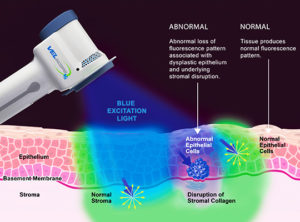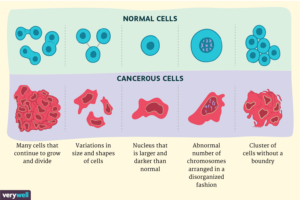Abstract:
Cancer is a leading cause of death worldwide as many patients are not aware that they have one. This results in the growth of cancer cells and by the time doctors are aware of it the patient’s life is at great risk. In order to have an early awareness of cancer, I have written this article to make sure we all understand the symptoms of cancer and how it can be treated. The study also includes the working of a device named veloscope, which is used by doctors to observe oral tissue abnormalities like cancer. This device has been helpful to save millions of lives as it reduces the risk of death from cancer since early awareness can make it easier for doctors to treat cancer cells. The main focus of this article is to demonstrate the in-depth working of velscope and explore what are cancer cells and how they differ from healthy cells.
Object and Mechanism Description
What is Velscope?
Velscope is a non-invasive oral screening device used to help visualize oral tissue abnormalities, which include cancer, tumors, and infections. This device does not require any prolonged testing and can be performed in a routine dental exam in about two minutes.
Velscope is a device often used by dentists and their hygienists. It is small and easy to hold. It was invented in 2006 by Peter Whitehead, the CEO and founder of LED Dental. A velscope kit comes with a velscope (see the

picture on the right), a pair of glasses, a phone holder (used to take pictures), a disposable plastic sheath, and a single-use lens cap (to prevent cross-contamination). The velscope itself has a big lens on its top, which is used for zooming in and out to observe the mouth tissues. It also has a power button on its front, which is used to turn on the blue light. When the velscope was first invented, it came with a wire for electricity supply, to support the metal halide (a binary compound of halogen) bulb. Eight years later, a cordless velscope was introduced with 16 LEDs.
Diagram:

In figure #2, we can clearly observe blue light being projected into a person’s mouth. This blue light changes into different colors based on whether the tissues are normal epithelium or abnormal. In the abnormal tissues, stroma (connective tissue) are disrupted and shown to contain blue sack, whereas normal ones are shown as regular red colored tissues.
How it Works?
This device throws a blue light, which is used to excite the “fluorophores” molecules that are present in the mucosal tissues. Mucosa is composed of epithelium cells that line various cavities in the body and covers the surface of the internal organs. In response to blue light, fluorophore produces its own light in shades of green, yellow or red. (The yellow and red shade show diseases and the light green color represents healthy gums) The filter in the velscope blocks the reflected blue light and increases the difference between normal and abnormal tissue, which helps detect cancer cells. A velscope can only detect abnormalities like cancer cells and tumors; it cannot diagnose them.
The velscope is mostly used by dentists and hygienists to check for abnormalities in the mouth. This dental exam is harmless, and it takes only a few minutes, so it can be performed regularly during dental visits. This exam should be performed once a year, but in a few cases, it must be performed two to three times a year. These exceptional cases are the ones in which either the patient smokes or has a family history of cancer or other diseases. A velscope exam is not expensive, but the cost of the whole exam can be high because dentists and hygienists perform it.
Interesting Factual Benefit of Velscope:
The use of a velscope is important to learn, especially for dentists as it helps them detect diseases that cannot be observed with the naked eye. In the United States oral cancer kills one person every hour because people are not aware of their cancer. Therefore, this harmless and time-saving device has been a great success, helping dentists save millions of lives.
Process Description
What is Cancer?
Cancer is basically a shared name for related diseases found in the human body. These diseases include prostate, oral, breast and lung cancer, among others. In total there are over 200 types of cancers found in human bodies. Abnormal tissue growth is the common element among all these diseases that give rise to the shared name cancer. The causes of cancer include toxic chemical exposure, radiation, pathogens, and genetic inheritance.
Symptoms of cancer include weight loss, fatigue, pain, skin changes, change in bladder function, cough, lumps, unusual bleeding and fever.
How Do Cancer Cells Replicate?
Humans are made up of billions of functional units called cells. These cells work together and form tissues, organs and organ systems. These organ systems then ultimately make up the human body. In cancer the excessive growth of new cells is responsible for destroying the human tissues and organs, which then leads to human death.
Diagram:

Figure #3 shows us the difference between normal and cancer cells. Normal cells are basically the ones that divide and form new cells only when needed. However, cancer cells grow even when there is no need of them by the body. These cells stop communicating with other cells and in response keep producing cells, which then form a cluster called a tumor.
|
Cancer Cells |
Normal Cells |
| 1- Keep replicating, even when the body does not need them.
2- Stop communicating with other cells. 3- Either do not die or do not undergo apoptosis(repair). 4- These cells are not able to produce stickiness, which is necessary for cells to work together as a group. 5- These cells can spread and travel through the bloodstream. 6- Cancer cells appear larger, darker with irregular shape, when observed under a microscope. 7- Such cells reproduce even when they are not mature yet. 8- In some cases, cancer cells do not perform their function. |
1- They only divide, when there is a requirement by the body.
2- Always communicate, to make sure what the body needs. 3- Normal cells undergo apoptosis (repair) or die when they get old. 4- Always produce stickiness, to stay together with other cells. 5- Such cells can not travel through the bloodstream. 6- These cells have a normal regular shape, with a proper nucleus. 7- Normal cells only reproduce when they are mature. 8- They always function normally and support human organs.
|
In a survey by the WHO (World Health Organization), it was accounted that cancer is the leading cause of death worldwide. So, it is always important to take precautions and stay up to date with your doctors.
References
“Velscope Technology.” LEDApteryx, ledapteryx.com/velscope/velscope-technology/.
“How Does the Velscope Work?” Velscope Oral Cancer Screening Explained | Kirkland WA Dentist, www.jenkimdentistry.com/faq/light-velscope-blue-tissues-fluorophores/2861.
“Mucosal Tissue.” NeuroImage, Academic Press, www.sciencedirect.com/topics/medicine-and-dentistry/mucosal-tissue.
“VELscope System Honored.” DentistryIQ, 7 July 2010, www.dentistryiq.com/articles/2010/07/velscope-system-honored.html.
“DeClerck Family Dental.” Dentist in Findlay, OH, www.declerckfamilydental.com/blog/post/how-often-should-i-get-screened-for-oral-cancer.html.
Davis, Charles Patrick. “Cancer Causes, Types, Treatment, Symptoms & Signs.” MedicineNet, www.medicinenet.com/cancer/article.htm.
Eldridge, Lynne, and Grant Hughes. “Cancer Cells vs. Normal Cells: How Are They Different?” Verywell Health, Verywellhealth, www.verywellhealth.com/cancer-cells-vs-normal-cells-2248794.




